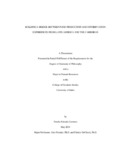| dc.contributor.author | Estrada Carmona, Natalia | es_ES |
| dc.date.accessioned | 2015-07-23T15:49:24Z | |
| dc.date.available | 2015-07-23T15:49:24Z | |
| dc.date.issued | 2014 | |
| dc.identifier.uri | https://repositorio.catie.ac.cr/handle/11554/7114 | |
| dc.description | Tesis (Mag. Sc.) -- CATIE, 2014 | |
| dc.description.abstract | Latin America and the Caribbean (LAC) region is a place where innovation to manage natural resources is taking place. The region is and will keep contributing to the global food market. However, this poses a threat to the biodiversity hotspots and the key ecosystem service they provide at local, national and global scale. The Integrated landscape management (ILM) and the Ecosystem Services (ES) approach are being widely used in the region to mediate between food production and conservation. Still, we lack information in terms of how common is the ILM implemented as a participatory and integrative strategy that engages local and regional stakeholders to promote sustainable agricultural production, biodiversity conservation and improvement of community’s livelihoods. In addition, we lack a quantified understanding of which practices guarantee ES provisioning at the site level and how site level implementations across a watershed improve larger scale services in agroecosystems. To assess if ILM is a promising approach to mediate between food production and conservation we surveyed 107 and interviewed 23 initiatives applying ILM in the region. We found that ILM is
improving natural resources management, engaging farmers, empowering local leaders and increasing the ability of communities to self-organize while increasing their capacity to understand and implement landscape management. The progress and success of these initiatives is highly dependent on sufficient and sustainable sources of funding and support, on decreasing policies and laws that hinder integrated landscape management and, on developing strategies to actively involve key stakeholders, government and private sector entities.
We also assessed site level efforts (such as implementing soil conservation practices) on watershed scale ES provisioning (such as reducing sediment yields in reservoirs for hydropower prodiction). We used a coupled economic and soil loss model to evaluate multiple strategies for reducing soil loss and compared these estimates to the costs of dredging three reservoirs in the upper and middle part of the iv Reventazon River, Costa Rica. Our results indicate that the cost of implementing ideal cropping systems (combination of at least two or three soil conservation practices) is potentially similar or cheaper than dredging, given our modeling assumptions. Our empirical-based and conservative methodology can be adapted and modeled iteratively to improve PES spatial planning in agroecosystems. | en_EN |
| dc.language.iso | en | es_ES |
| dc.publisher | CATIE, Turrialba (Costa Rica) | es_ES |
| dc.relation.ispartof | Maestría en Socioeconomía Ambiental | |
| dc.subject | SEGURIDAD ALIMENTARIA | |
| dc.subject | PRODUCCION ALIMENTARIA | |
| dc.subject | GESTION INTEGRADA | |
| dc.subject | PAISAJE AGRICOLA | |
| dc.subject | ECOSISTEMA | |
| dc.subject | CONSERVACION | |
| dc.subject | BIODIVERSIDAD | |
| dc.subject | MEDIOS DE VIDA SOSTENIBLES | |
| dc.subject | CONSERVACION DE SUELOS | |
| dc.subject | CUENCAS HIDROGRAFICAS | |
| dc.subject | MODELIZACION DEL MEDIO AMBIENTE | |
| dc.subject | AMERICA LATINA | |
| dc.subject | CARIBE | |
| dc.title | Building a bridge between food production and conservation: experiences from Latin America and the Caribbean | es_ES |
| dc.type | Tesis de maestría | es_ES |
| dc.identifier.publisher | CATIE | es_ES |
| dc.identifier.publication | CATIE | es_ES |


